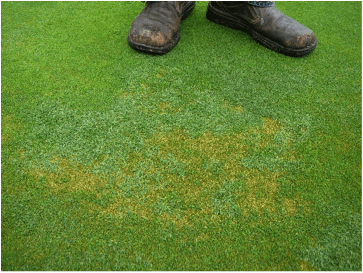How To Manage Anthracnose This Growing Season

No one wants to find anthracnose lurking on their turf; it’s ugly and destructive. But, when turf is stressed, whether physiologically or mechanically, the probability of anthracnose developing is high. Education is your first line of defense when combating anthracnose and Rutgers University has taken a lead role with their ongoing 15+ year study. Here are important key points from the Rutgers study, which were sourced at the 2017 GIS show.
First and foremost, let’s learn a little more about the basics of anthracnose. Anthracnose is caused by a fungal organism and infects certain areas of the grass plant. The area the organism infects distinguishes the type of anthracnose symptoms that can be seen in the plant. There are two types of symptoms: foliar and basal rot.
- Foliar. Foliar anthracnose symptoms normally involve a yellowing of leaf tissue, which produces an irregular, patchy pattern in the infected areas of turf. Both annual bluegrass (Poa annua) and creeping bentgrass can be affectedfromfoliar anthracnose. Annual bluegrass is more vulnerable, however, and will often show symptoms, while creeping bentgrass remains healthy and does not show symptoms.
- Basal Rot. Basal rot anthracnose affects the crown of turf plants and causes turf thinning. Symptoms include a darkening of the crown and collapse of the plant.
In both types of symptoms, structures called acervuli are produced. They are dark, disk-shaped structures and contain fungal spores. Acervuli can be seen with a magnifying glass when tissue is infected.
Now that the basics are out of the way, let’s discuss how to manage anthracnose.
In the springtime, apply granular fertilizer with a 1:1 ratio (nitrogen to potassium). Seasonal topdressing every 2 weeks is recommended. Remember, stress contributes to anthracnose development, so moisture management is critical. Drought stress and saturated conditions contribute to disease activity (physiological stress).
Preventive fungicide applications are key to anthracnose treatment success. Suggested rotational fungicides are Echo Dyad (chlorothalonil w/pigment), ArmorTech CLT 720/825 (chlorothalonil), ArmorTech Teb 360 (tebuconazole), Triton (triticonazole), Signature XTRA, ArmorTech Zoxy (azoxystrobin), and Fame (fluoxistrobin).
Of the dmi fungicides, tebuconazole is the most effective, followed by triticonazole for anthracnose control. Rutgers University Professor, Dr. Bruce Clark, recommends applying QOI fungicides (strobilurins), such as azoxystrobin or fluoxistrobin, as a preventative application. QOI fungicides have limited curative control on anthracnose, so they are best suited for preventative application.
Of the above-mentioned practices, the greatest influence for reducing anthracnose is the spring-applied granular fertilizer with a 1:1 ratio of nitrogen to potassium. Through the summer months, it would be prudent to partner foliar potassium, such as Foliar-Pak 11-0-11, Foliar-Pak 1-0-15 or Foliar-Pak Armament K, and ArmorTech 44 (urea phosphite) or ArmorTech 28 (potassium phosphite) with the aforementioned fungicides.
Now that you are armed with some education on anthracnose, hopefully, you feel more prepared to tackle an anthracnose problem when it arrives. Don’t hesitate to ask your ATS Sales Rep for more education and help. Together, you and your ATS Sales Rep, can prevent the ugly and destructive disease from attacking your turf.
Stuart Cagle
ATS Vice President of Operations







